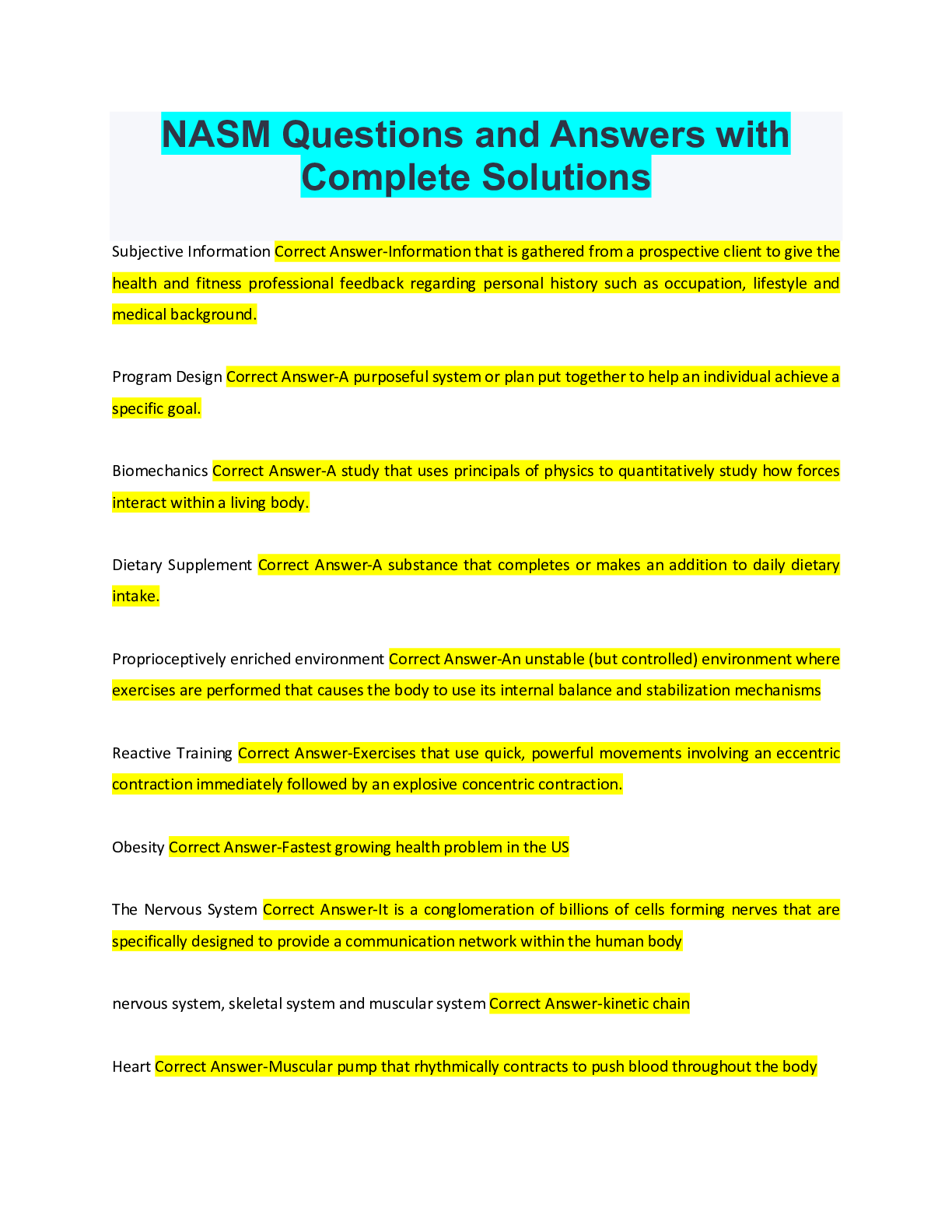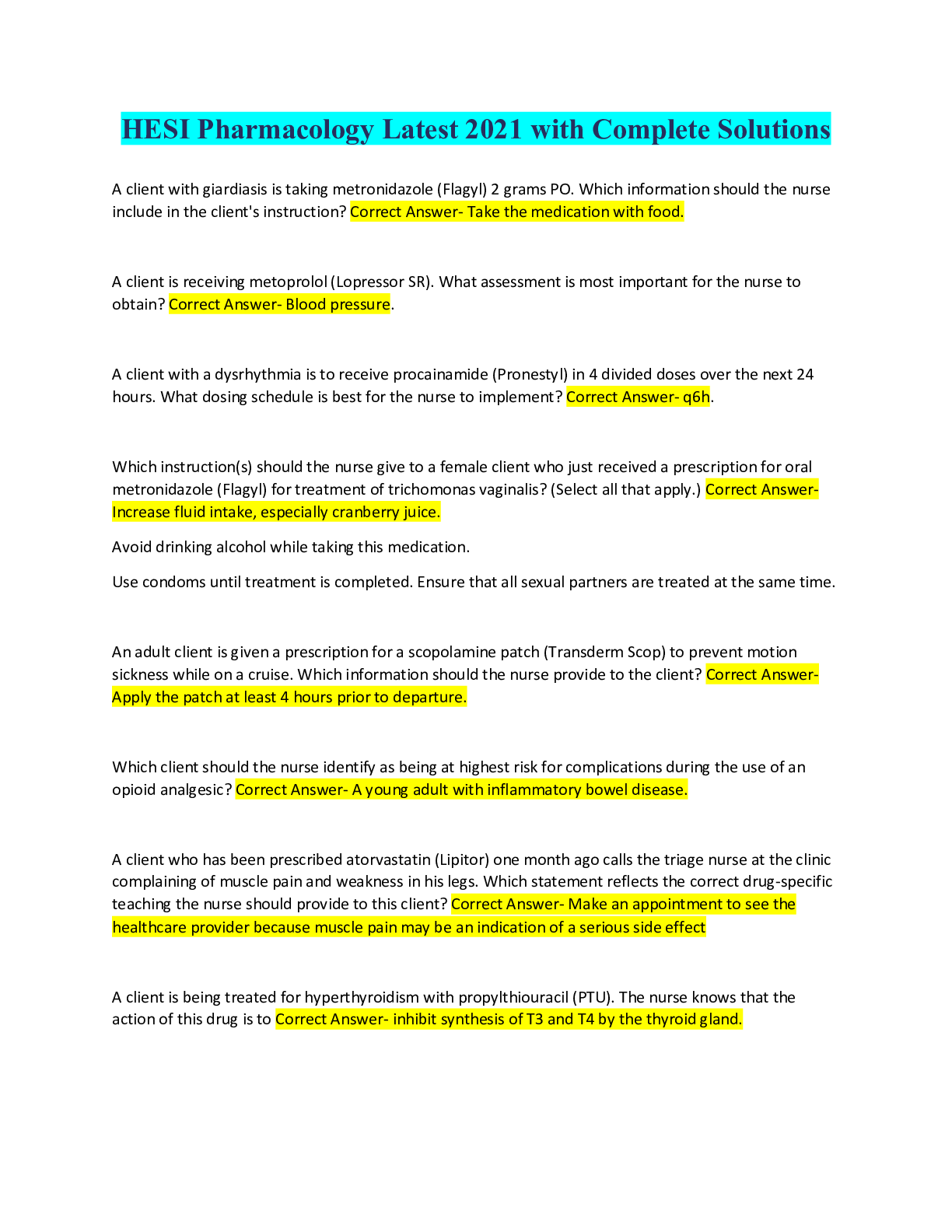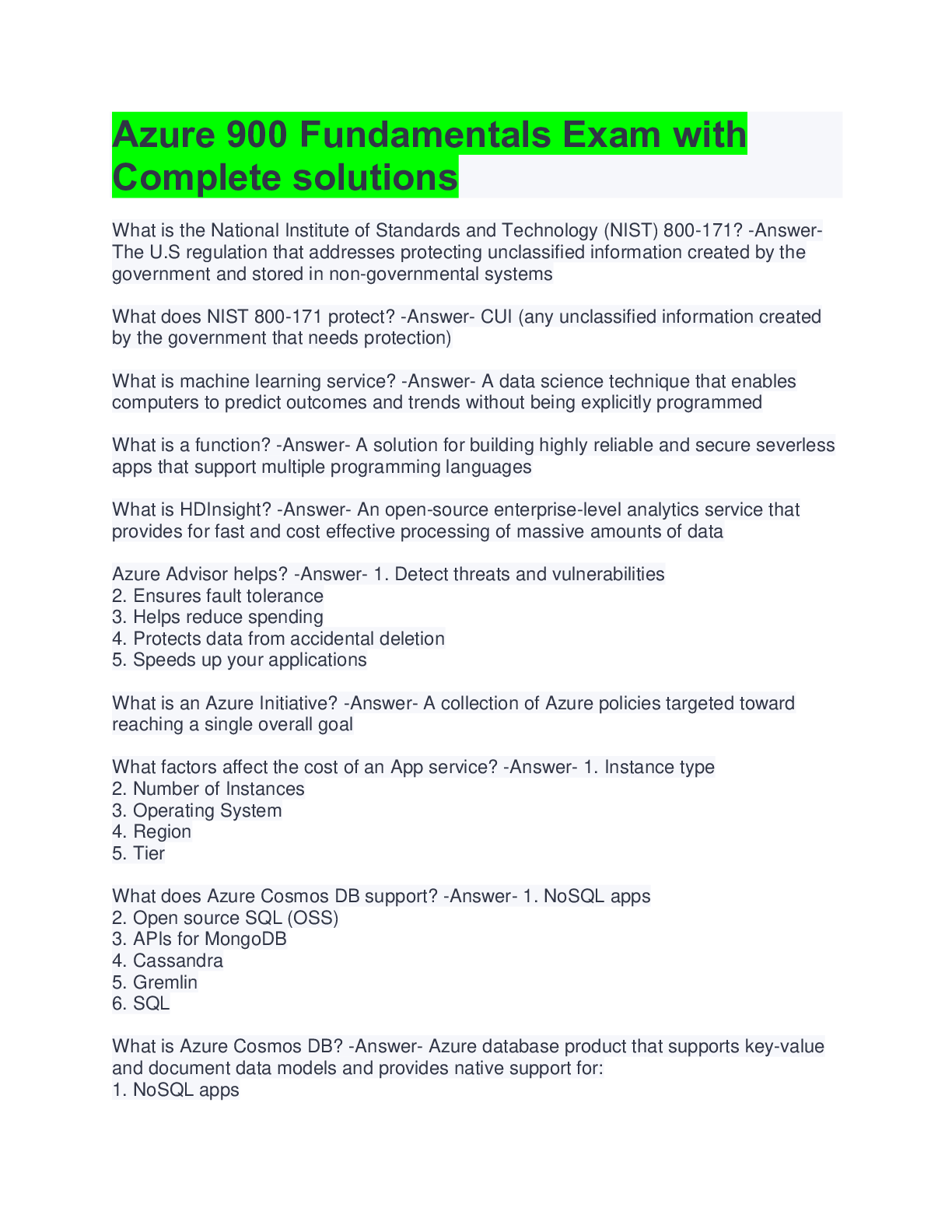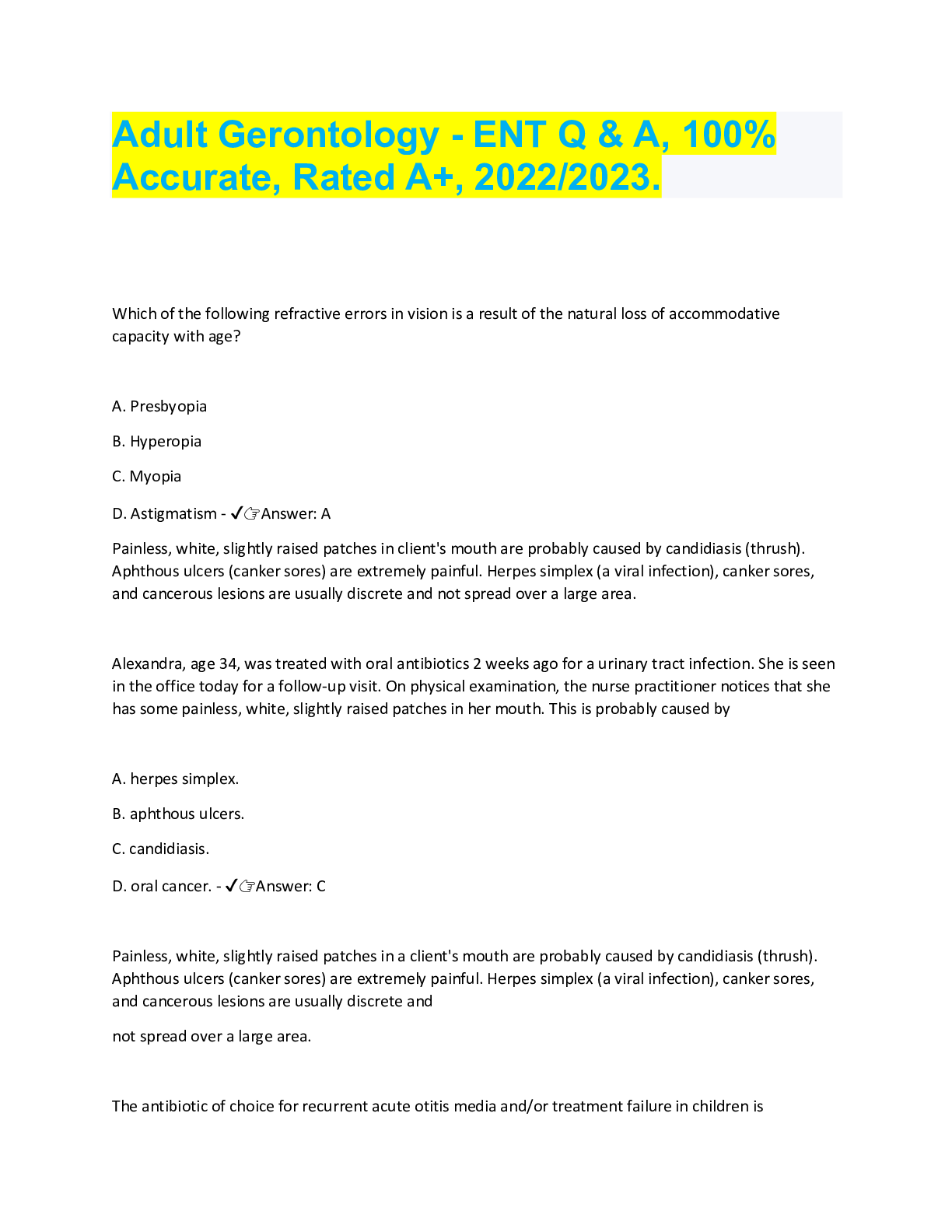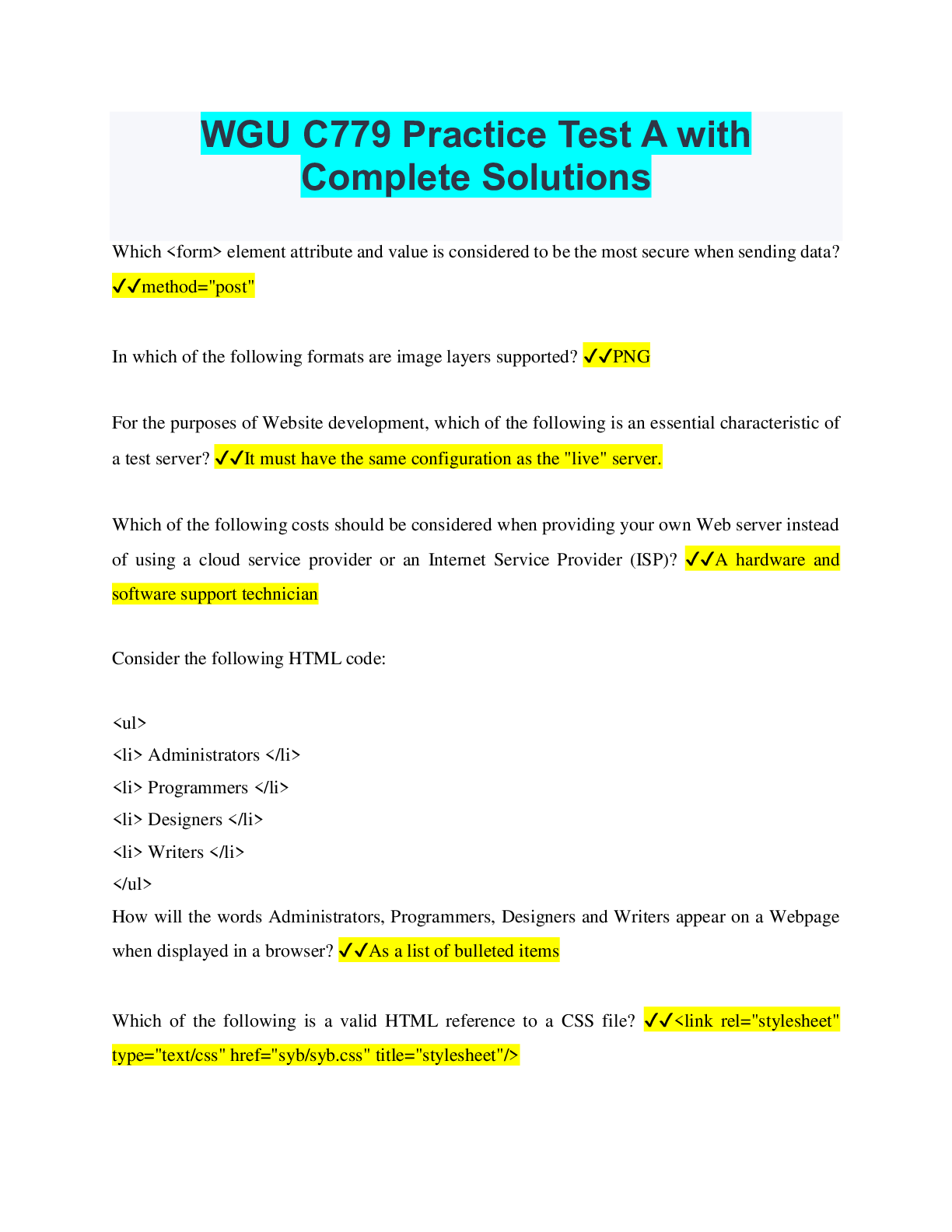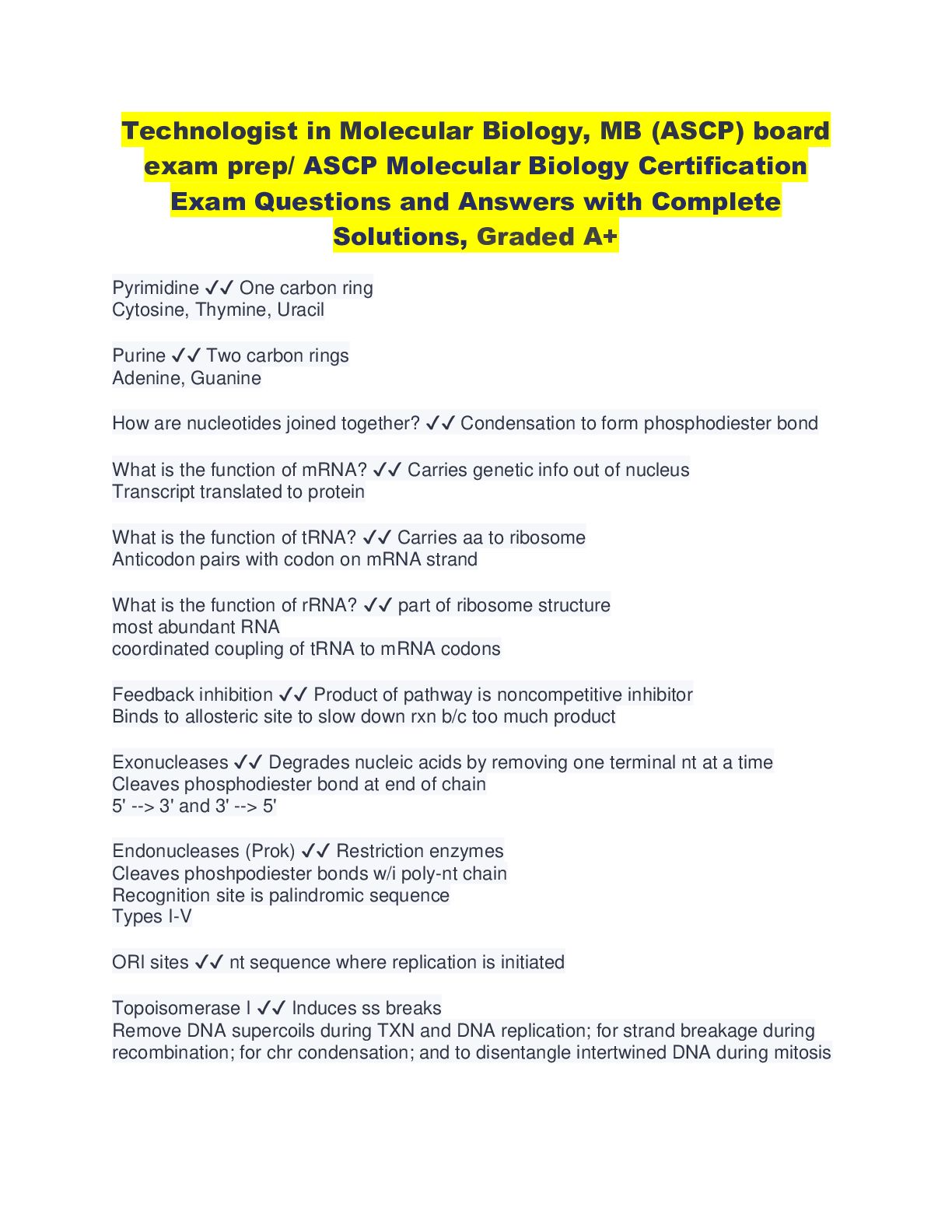*NURSING > QUESTIONS & ANSWERS > Advanced Trauma Life Support Questions with Complete Solutions, Rated A+, 2022/2023. (All)
Advanced Trauma Life Support Questions with Complete Solutions, Rated A+, 2022/2023.
Document Content and Description Below
Advanced Trauma Life Support Questions with Complete Solutions Basic Outline of ATLS Protocol? -Answer- 1. Preparation 2. Triage 3. Primary survey (ABCDE) 4. Adjunct to Primary survey 5. Re-asse... ss ABCDE and consider need for transfer 6. Transfer if needed 7. Secondary Survey (AMPLE + all physicals) 8. Adjuncts to second Survey 9. Pt. re-evaluation 10. Definitive Care. What is included in the Primary survey of a trauma patient? -Answer- -Airway and CSpine -Breathing and Ventilation -Circulation/bleeding control -Disability (Neuro Eval) -Exposure and Environmental control. What are adjuncts to Primary Survey and Resuscitation? -Answer- ECG monitoring Urinary/Gastric Catheters Other Monitoring (ABG, capnography) X-ray and Dx studies. What makes up the Secondary Survey? -Answer- AMPLE Hx and Detailed Physical Exam Mechanism of Injury Head and Maxillofacial C-spine Chest Abdomen Perineum/Rectum/Vagina Musculoskeletal Neurologic What is something you could do to get a quick assessment of ABCD? -Answer- Ask the pt. a question. If they can respond it can give you an idea about their airway and mental status. Failure to respond tells you there are abnormalities in ABCD. What assumption can safely be made in a pt. with blunt multisystem trauma above the clavicle or Altered mental status? -Answer- That the C-spine is compromised. 4 Steps to manage A? -Answer- Assess for patency Establish airwayMaintain C-spine Reinstate Proper C-spine devices. 2 steps to Breathing? -Answer- 1.Expose Neck and chest to inspect and palpate. Percuss chest for presence of dullness or hyperresonance, auscultate chest bilaterally. All this checking for Tension Pneumo, Flail chest, Hemothorax, Open Pneumothorax. 2. Administer High concentration O2, ventilate with bag, alleviate Tension Pneumo, attach CO2 monitor to ET tube, Pulse ox. What is the predominant cause of preventable deaths after injury? -AnswerHemorrhage. 2 steps to managing C? -Answer- 1. Identify any sources of external/internal bleeding bleeding. The four big areas for massive bleeding include: Chest, Abdomen, Pelvis, Femur Fx. Assess Pulse quality, color of skin level of consciousness, BP. 2. Large bore IVs and obtain blood samples. Type and cross, ABG. Warm Fluids/blood. T or F: Aggressive and continued volume resuscitation is not a substitute for definitive control of hemorrhage. -Answer- True. best way to stop shock? -Answer- 1) ID and stop the bleed -> enhances VR 2) volume repletion - but will only help if the source of the bleed is identified - restores CO, end organ perfusion, tissue oxygenation Do u need a surgeon in a trauma shock? -Answer- - yes! - presence of shock in a trauma pt warrants immediate involvement of a surgeon - arrange early transfer if not equipped to handle injuries Blood loss Classifications? -Answer- Class 1: <15% -> no s/s -> blood donation -> monitor Class 2: 15-30% -> low pp, tachy/tachypn, urine output mildly affected -> crystalloids Class 3: 30-40% -> " " and low urinary flow -> stop hemorrhhage/embolization -> crystalloids +/- BLOOD Class 4: >2000mL Loss= >40% -> surgery & massive transfusion Urine output will be less. HR will increase. BP decreases Respiratory Rate Increases.At what class Should you start Blood transfusing? -Answer- Class 3 or higher. 3 Steps to D? -Answer- 1. Establish consciousness w/ Glasgow score. 2. Pupil size and reaction Blown and dilated pupils indicate intracranial hemorrhage or swelling with increased ICP 3. Lateralizing signs. If they are moving, are they moving both sides equally, are there any signs of spinal cord injury level What is assessed in glasgow? -Answer- eyes response= 4 Verbal response=5 Motor Response=6 At what Glasgow score should you intubate? -Answer- 8 How can you control Exposure/Environment? -Answer- Undress pt. Prevent Hypothermia Warmed IV fluids. Room temp maintained appropriately. What are some adjuncts that may be used during primary survey? -Answer- ECG, ABGs, ET CO2, FAST ultrasound, DPL, Chest and pelvic Xrays, Urinary/Gastric Catheters When can the Secondary survey begin? -Answer- When the Primary survey is completed, resuscitative efforts are underway and normalization of Vital functions has been demonstrated. 18 Steps to Secondary Survey? -Answer- 1. AMPLE Hx 2. Mechanism of injury (Blunt/penetrating?) 3. Head/Maxillofacial (lacerations, contusions, pupils, Ears, nose and mouth for blood or CSF, eyes, CN function. Reassess GCS., Visual acuity 4. Maintain airway, Control hemorrhage, Prevent Secondary brain injury like anoxic or cerebral edema. Remove contact lenses. 5. C-spine and neck. Tracheal deviation, blunt or penetrating trauma, Respiratory muscles, carotid arteries for bruits, symmetry of pulses. Obtain CT of cervical spine or a lateral, cross-table spine xray. 6. In-line immobilization and protection of C- spine. 7- Chest: Palpate, Auscultate, Percuss, check for flail chest, contusion, bleeding, breathing.8- Chest management: Needle decompression, Chest tube, Pericardiocentesis, Dressing any chest wounds. 9- Abdomen: Rigidness, AAA, Tenderness, Ultrasound, muscle guarding, bowel sounds, percussion, palpation, signs of blunt or penetrating trauma. Pelvic Xray, CT of abdomen. 10. Management of abdomen Immediate surgery for exploratory laparotomy, Pelvic compression binder. pregnancy. 11. Perineal Assessment for contusions, lacerations or bleeding. 12. Rectal assessment Bleeding, sphincter tone, bowell wall integrity, bony fragments, prostate position. 13. Vaginal Assessment in select pts. Presence of blood. Pregnancy. Exploratory surgery. 14. Musculoskeletal Assessment: Inspect extremities for blunt or penetrating trauma, deformities, lacerations, sensation, Pulses, fractures, control any bleeding if not done yet. Inspect and palpate throacic and lumbar spines for injury, deformity. X rays for suspected fracture sites. 15. Musculoskeletal management: Immobilization of thoracic spine, splinting, wrap sheet around pelvis for compression binder to help control pelvic bleeding. CONSIDER COMPARTMENT SYNDROME!!!!!! 16. Neurologic: Determine GCS again, upper and lower extremities for motor and sensory functions. Protect spinal cord until injury is ruled out. 17. Management: Continue ventilation and oxygenation of pt. and maintain immobilization of entire pt. 18. Adjuncts: Obtaining Dx tests and imaging as necessary. What comes after the Secondary survey? -Answer- Continued monitoring for any changes in pts. responsiveness and vital signs, urine output. Transfer to definitive care. Direct communication provider to provider. SHOCK -Answer- SHOCK Definition of shock -Answer- abnormality of circulatory system that results in inadequate organ perfusion and tissue oxygenationMCC of shock in trauma patients? -Answer- hemorrhage 2 broad categories of shock -Answer- 1. hemorrhagic 2. non-hemorrhagic 4 types of shock -Answer- CONS C - cardiogenic O - obstructive (tamponate, tension pneumo) N - neurogenic S - septic (old person think UTI) Whats the earliest sign of hemorrhagic shock? -Answer- tachycardia * any pt who is cool to touch and tachy = is in shock until proven otherwise - shock -> less blood flow to skin, mm visceral circulation -> more blood for kidneys, heart brain -> so get foley, EKG and neuro checks - also look for pulse rate, character, resp rate, skin perfusion and PP (should be decreased) HR varies w/ age - infant? - preschool? - school - puberty? - adult? -Answer- - infant (brith to one) > 160 - preschool >140 - school - puberty >120. * 12 = puberty - adult >100 old ppt can have lower thresholds b/c on BB and less response to catecholamines w/ age -> look for narrow pulse pressure! HEAD TRAUMA -Answer- HEAD TRAUMA Whats the primary goal of treatment for pts with suspected traumatic brain injury (TBI?) -Answer- prevent a secondary brain injury - so adequate O2 and enough BP to perfuse the brain - CT scan shouldn't delay pt transfer to a trauma center that's capable of neurosurgical intervention What to say to neurosurgeon consult when transferring? -Answeruncal herniation -Answer- IPSI blown pupil (CN III and PSNS messed up in temporal lobe - contralateral hemiparesisintracranial pressure normal? elevated? what happens when ICP goes up? -Answer- normal - 10mmHg if >22 = poor outcomes if ICP goes up -> reduces cerebral perfusion -> :( ischemia What is the monro-kellie doctrine that helps to describe ICP dynamics -Answer- total volume of intracranial contents remains constant -> when we exceed it -> higher ICP -> compresses brain and cerebral perfusion and CSF -> brain also responds to changes in partial pressure of oxygen (PaO2) and pp of CO2 (PaCO2) so secondary injury can occur from... -Answer- hypoxia, hypotension, hypercapnia and iatrogenic hypocapnia - * make every effort to enhance cerebral perfusion and blood flow by reducing high ICP, maintain normal iintravasc volume and MAP, restore normal oxygenation and ventilation, hematoma and other lesions that increased intracranial volume should be evacuated early Why do we use GCS? -Answer- to assess severity of brain injury <8 = coma or brain injury 9-12 = moderate 13 - 15 - mild * when there is motor asymmetry - use the best motor response to calculate score, b/c its the most reliable predictor of outcome What do skull fractures tell us? -Answer- it took a great deal of force to get this When u get a contusion what test to order? -Answer- repeat CT to evaluate for changes int he pattern of injury within 24 hours of initial scan Traumatic brain injury includes... -Answer- diffuse injury, and focal (epidural, subdural, contusions and intracerebral hematoma) GCS Score? -Answer- 3 = worst 15 = best https://www.youtube.com/watch?v=h2SIN7Mn0YA PT hit head in sports, now is awake, conscious now oriented, had amnesia, transient loss of consciousness, headache GCS 13-15 -Answer- mild Brian injury [Show More]
Last updated: 2 years ago
Preview 1 out of 13 pages
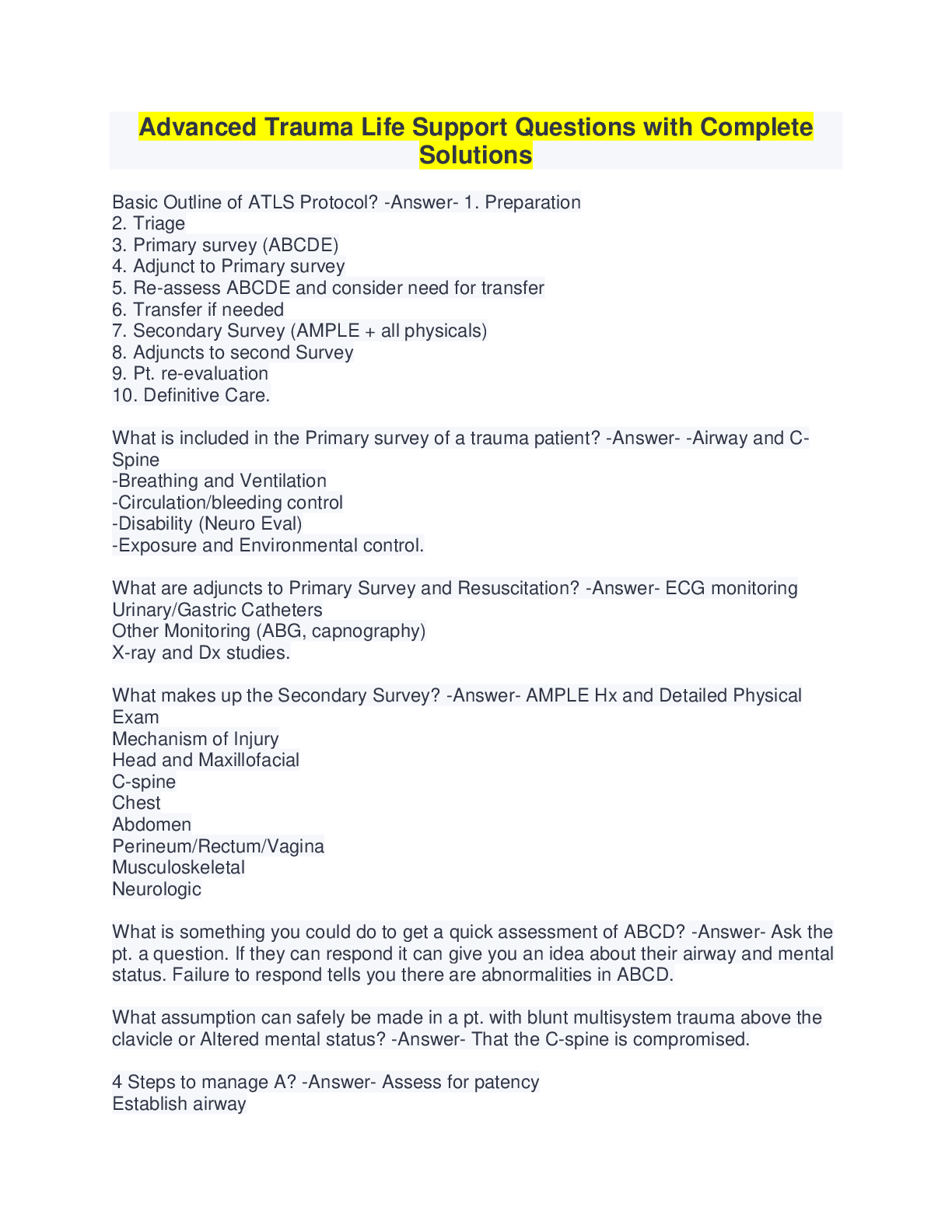
Buy this document to get the full access instantly
Instant Download Access after purchase
Buy NowInstant download
We Accept:

Reviews( 0 )
$8.00
Can't find what you want? Try our AI powered Search
Document information
Connected school, study & course
About the document
Uploaded On
Sep 20, 2022
Number of pages
13
Written in
Seller

Reviews Received
Additional information
This document has been written for:
Uploaded
Sep 20, 2022
Downloads
0
Views
107












.png)
